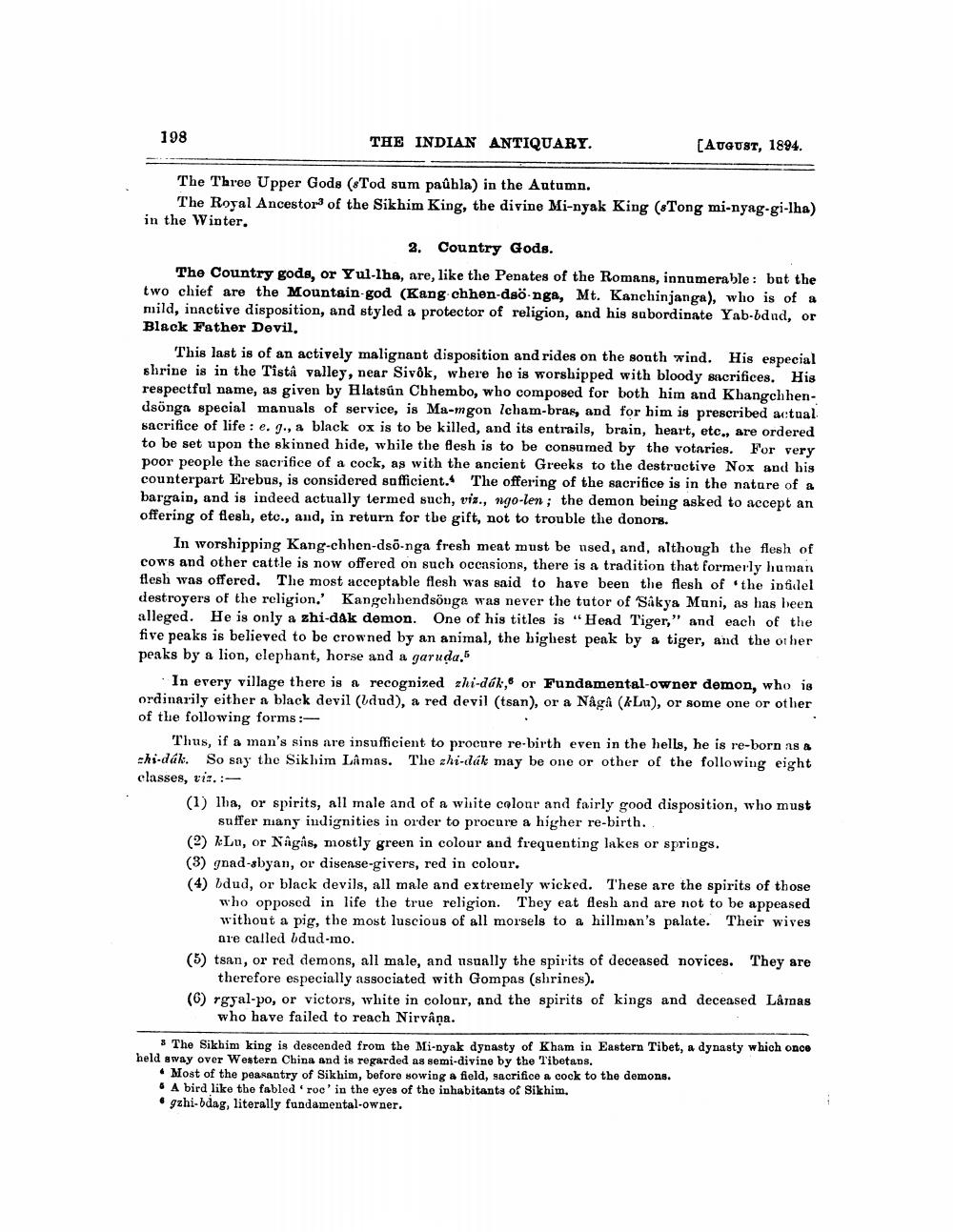________________
198
THE INDIAN ANTIQUARY.
(AUGUST, 1894.
The Three Upper Gods (sTod sum pallhla) in the Autumn.
The Royal Ancestor of the Sikhim King, the divine Mi-nyak King (sTong mi-nyag-gi-lha) in the Winter,
2. Country Gods. The Country gods, or Yul-Iha, are, like the Penates of the Romans, innumerable: but the two chief are the Mountain god (Kang chhen-dsö nga, Mt. Kanchinjanga), who is of a mild, inactive disposition, and styled a protector of religion, and his subordinate Yab-bdud, or Black Father Devil.
This last is of an actively malignant disposition and rides on the south wind. His especial shrine is in the Tista valley, near Sivok, where he is worshipped with bloody sacrifices. His respectful name, as given by Hlatsún Chhembo, who composed for both him and Khangchhendsönga special manuals of service, is Ma-mgon lcham-bras, and for him is prescribed actual sacrifice of life : e. 9., a black ox is to be killed, and its entrails, brain, heart, etc., are ordered to be set upon the skinned hide, while the flesh is to be consumed by the votaries. For very poor people the sacrifice of a cock, as with the ancient Greeks to the destructive Nox and his counterpart Erebus, is considered sufficient. The offering of the sacrifice is in the nature of a bargain, and is indeed actually termed such, viz., ngo-len; the demon being asked to accept an offering of flesh, etc., and, in return for the gift, not to trouble the donors.
In worshipping Kang-chhen-dso-nga fresh meat must be used, and, although the flesh of cows and other cattle is now offered on such occasions, there is a tradition that formerly human flesh was offered. The most acceptable flesh was said to have been the flesh of the infidel destroyers of the religion.' Kangchhendsönga was never the tutor of Sakya Muni, as has been alleged. He is only a zhi-dAk demon. One of his titles is "Head Tiger," and each of the five peaks is believed to be crowned by an animal, the highest penk by a tiger, and the other peaks by a lion, elephant, horse and a garuda.
In every village there is a recognized zhi-dák, or Fundamental-owner demon, who is ordinarily either a black devil (Udud), a red devil (tsan), or a Naga (KLu), or some one or other of the following forms:
Thus, if a man's sins are insufficient to procure re-birth even in the hells, he is re-born as a chi-dák. So say the Sikhim Lâmas. The zhi-dák may be one or other of the following eight classes, viz. :
(1) lha, or spirits, all male and of a white colour and fairly good disposition, who must
suffer niany indignities in order to procure a higher re-birth. (2) Lu, or Nagas, mostly green in colour and frequenting lakes or springs. (3) gnad-sbyan, or disense-givers, red in colour. (4) idud, or black devils, all male and extremely wicked. These are the spirits of those
who opposed in life the true religion. They eat flesh and are not to be appeased without a pig, the most luscious of all morsels to a hillman's palate. Their wives
are called bdud-mo. (5) tsan, or red demons, all male, and usually the spirits of deceased novices. They are
therefore especially associated with Gompas (shrines). (6) rgyal-po, or victors, white in colour, and the spirits of kings and deceased Lâmnas
who have failed to reach Nirvana.
3 The Sikhim king is descended from the Mi-nyak dynasty of Kham in Eastern Tibet, a dynasty which once held away over Western China and is regarded as semi-divine by the Tibetans.
. Most of the peasantry of Sikhim, before sowing a field, sacrifice a cock to the demons. • A bird like the fabled 'roc' in the eyes of the inhabitants of Sikhim,
gzhi-bdag, literally fundamental-owner.




